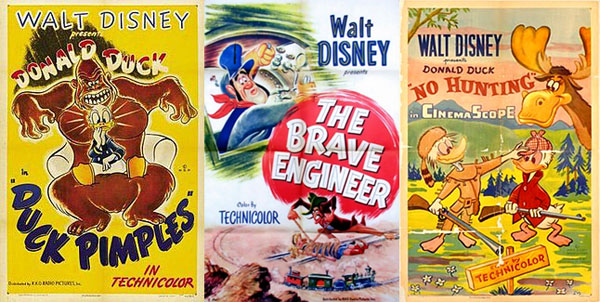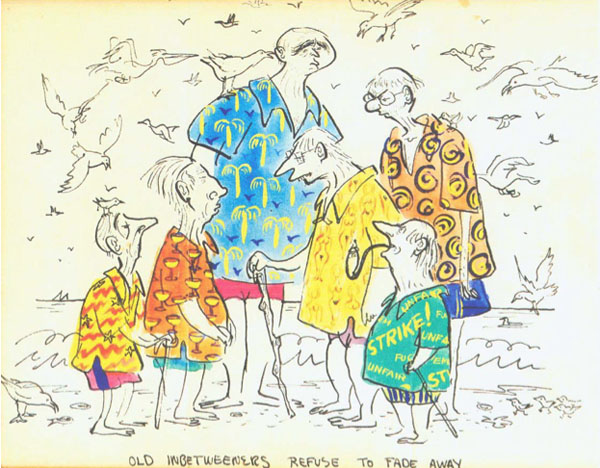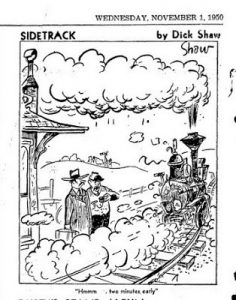Suspended Animation #318
So many talented people worked at the Disney Studios over the decades that is hard to keep track of all of them. For most of us they may be just a name that we saw on the credits of a cartoon. Some never even got that much recognition.
Today, I thought I would focus on Dick Shaw and Brice Mack who were accomplished cartoonists, good friends and worked during the Golden Age of Disney Animation at the Disney Studio and may not be well known.

Dick Shaw started work at Disney in 1941 and left in 1955. He wrote the Mickey Mouse comic strip drawn by Floyd Gottfredson from 1942-1943. He was a close friend of VIP Partch and they both loved boating. Shaw’s boat was called the Michigan.
As fellow columnist Devon Baxter has recently pointed out: “Shaw, a freelance cartoonist who wanted to get into the animation field, met Partch at a bar near the Burbank studio. Partch worked as an assistant animator in the early 1940s and wanted to pursue magazine cartooning, but hesitated to send his artwork to publishers.

From the opening titles of GUMSHOE MAGOO (1958)
With Partch, Shaw wrote the Donald Duck cartoon Duck Pimples (1945) and with Bill Berg did the story for Donald’s cartoon No Hunting (1955). He is also credited with Dick Kinney with the story for The Brave Engineer (1950) about Casey Jones as well as several other Disney cartoons including Make Mine Music (1946) Starting in 1955, he went to UPA as a storyman (on Mr. Magoo) until 1962.
Starting around 1963, Shaw was the humor editor for the magazine Orange County Illustrated. Thanks to Shaw the magazine had first rate cartoonists who were all Shaw’s buddies such as VIP, Phil and Frank Interlandi, John Dempsey and Matt Murphy.

Shaw’s main source of income was his relationship with the Lockheed Corporation. Lockheed published at least 2000 cartoons and illustrations by Dick Shaw (plus three or four cartoon collections that are difficult to locate today) including Flyby: A Parade of Chuckles from Lockheed that is an accumulation of “the best from five years of Lockheed Reports” that was sent to “Lockheed’s military friends”. Another compilation was Way Outer Space with Dick Shaw.
Shaw’s daughter Casey [Catherine] Shaw Shanley recalled: “I remember many funny stories about the strike at Disney, and I think Hank Ketcham was living with my parents at the time. I was born in 1956 so they were old stories when I heard them, but no one could tell stories better than those guys! I remember my mother saying how grateful she was that the Union gave milk to mothers with babies during the strike.”
Dick Shaw, Virgil Partch and Disney background artist Brice Mack among other cartoonist friends had many notorious parties and adventures. In 1950, for a FORD TIMES magazine article, they drove in the first Mexican Road Race. Another time they put a train car on a barge and partied as they drove it to Catalina Island.
Mack and his cartoon comrades once put wheels on a boat and partied as they drove it to Las Vegas where a crane waited to lower it into the pool of the Sands hotel.
In 1961, they held a party on the last Red Car ride from Los Angeles to Long Beach, dancing to the accompaniment of animator pal Ward Kimball’s Dixieland Jazz band, The Firehouse Five Plus Two.
Some wonderful examples of Shaw’s newspaper cartooning for the Redwood Weekly Gazette (a small California newspaper) with other examples of newspaper strips by Disney Studio artists as well including Jack Bradbury and Dick Lundy from 1950-1951 is at this link.
Mack and Shaw were the founding members of “The Balboa Island Punting and Skulling club” and organized the first character boat parade.

Brice Mack
Mack also worked as a writer in the story department and did illustrations for various Disney projects including a Peter Pan children’s book, and painting a Peter Pan mural in Captain Hook’s pirate ship at Disneyland which was completed just prior to the park’s opening.
Animation historian Harvey Deneroff did this interview with Mack.
During WW2 Mack left Disney in 1942 and became a pioneering navigator for the Air Transport Command. He delivered aircraft, cargo, and personnel throughout the world until the end of the war.
After the war, in 1945, Mack returned to Disney. In 1954 he left to start Era productions, a commercial production company specializing in animated commericals and later Unicorn Prods as well as continuing to consult for Disney until roughly a decade before his death.
 He continued producing and directing through the 1980s. Notably, Mack painted the first iconic Disney Castle illustration for The Wonderful World of Disney TV show.
He continued producing and directing through the 1980s. Notably, Mack painted the first iconic Disney Castle illustration for The Wonderful World of Disney TV show.
In addition to working for Disney, Brice also did freelance illustrations, articles and cartoons for magazines including Ford Times, Colliers, and True. One article he wrote and illustrated was about a new activity called “skin-diving”. Brice was an early pioneer of skin diving and made his own equipment. He loved diving for abalone and lobster in the rocky coves of Catalina Island.
Cartoonist Virgil Partch came to Southern California in 1937 and studied at the Chouinard Art Institute in California. He got a job at the Disney Studios as an office boy. In 1938 he became an animator and married Helen. After taking part in the Disney Studio strike in 1941, Partch was fired and started submitting his cartoons to various newspapers.
This watercolor drawing was done sometime in 1941/1942. and featured caricatures of some of the people he worked with at Disney.

Left to right: Sam Cobean, Tony Rivera, Bill McIntyre, Vip Partch, Reginald Massie (foreground), Dick Shaw. Titled Old Inbetweeners Refuse To Fade Away, this was done while the five men would have been in their late twenties to early thirties.
Sam Cobean who became a noted magazine cartoonist was in charge of publicity for the 1941 Disney strike. Tony Rivera was Grim Natwick’s assistant on Snow White. He worked for UPA, John Sutherland and DePatie-Freleng. He was one of the original Flintstones layout artists, and continued working for Hanna-Barbera until shortly before his death in 1986.
Bill McIntyre was in and out of the animation business for many years. Virgil “Vip” Partch went on to fame and fortune as a magazine cartoonist, and doing the newspaper panel comic Big George.
Reg Massie worked for George Pal, designing several of the Puppetoons such as John Henry and the Inky-Poo (1946) and the “Rome-Owww and Julie-Cat” puppetoon sequence in the all-star Paramount feature Variety Girl (1947). He went on to be an art director for magazines.
Dick Shaw, as I have mentioned, was a storyman (1941 -1955) at the Disney Studio and later went on to be a successful magazine cartoonist.



 Jim Korkis is an internationally respected animation historian who in recent years has devoted his attention to the many worlds of Disney. He was a columnist for a variety of animation magazines. With his former writing partner, John Cawley, he authored several animation related books including The Encyclopedia of Cartoon Superstars, How to Create Animation, Cartoon Confidential and Get Animated’s Animation Art Buyer’s Guide. He taught animation classes at the Disney Institute in Florida as well as instructing classes on acting and animation history for Disney Feature Animation: Florida.
Jim Korkis is an internationally respected animation historian who in recent years has devoted his attention to the many worlds of Disney. He was a columnist for a variety of animation magazines. With his former writing partner, John Cawley, he authored several animation related books including The Encyclopedia of Cartoon Superstars, How to Create Animation, Cartoon Confidential and Get Animated’s Animation Art Buyer’s Guide. He taught animation classes at the Disney Institute in Florida as well as instructing classes on acting and animation history for Disney Feature Animation: Florida.




















































Brice Mack also directed some feature films in the 1960s and ’70s, notably the 1978 American-International horror film JENNIFER, starring Lisa Pelikan, Nina Foch, Bert Convy and Jeff Corey.
I’m curious about Dick Shaw’s relationship with the Lockheed Corporation. I know that Lockheed was headquartered in Burbank and owned the city’s airport for many years, so it’s probable that they would have engaged Disney artists to provide cartoons and illustrations for its internal publications. But it seems remarkable that this would have been Shaw’s “main source of income” (the Flyby book was published in 1952, while Shaw was still working for Disney). If Lockheed sent these publications out to its military clients, they surely would have insisted on a high standard of quality, even though the publications themselves would have little or no monetary return. So I wonder if Shaw might have had a position with the company like Art Director for Corporate Publications, rather than being just a freelance cartoonist and illustrator.
In any case, the generous pay Shaw received for his Lockheed cartoons would have been only a minor factor in the massive billion-dollar debt that the company had accumulated by the early seventies (back when a billion dollars was real money), resulting in a very controversial bailout loan from the U.S. government. The bill barely squeaked through Congress thanks to Vice President Agnew’s tie-breaking vote in the Senate — and Lockheed paid off the loan, with interest, in a few years.
Dick Shaw and Brice Mack sound like a lot of the guys I grew up with in Detroit: never happier than when driving or working on some kind of motor vehicle — and the bigger, the faster, and the fancier, the better.
The Shaw and/or Kinney connection to “Gumshoe Magoo” goes deeper than the Mickey Mouse comic strip. That script was lifted directly from a Walt Disney Comics and Stories title for Goofy, “The Unknown Hero” – complete with identical matching list of errands for the Goof and the robber. One of both of the authors must have done work on the Goofy comics in addition to their work on the Mickeys.
Thanks Charles.-
Your response is the type of thing I value most about this website.
I have a couple of comic books which contain “The Unknown Hero” – I’ll check it out, and then review the cartoon.
Because “The Unknown Hero” was first published in 1958, they got paid twice in the same year for the story.
Hello Jim –
A possible future story suggestion.
The direct to DVD release of “Cinderella 2: Dreams Come True” (2002) was made up of individual segments. I suspect these were episodes for a proposed Cinderella cartoon show that was axed in-house.
Do you have any stories of unaired cartoon pilots based on Disney characters/movies that were developed by Walt Disney TV Animation circa 1986-2002? (Soon after that, with the exception of series based on The Emperor’s New Groove & Lilo And Stitch, they seemed to take a different route with TV animation)
I’m referring to ones which got past the pitch stage, to actually having scripts written, and maybe even partially animated.
Examples might be:
A Napoleon and Lafayette pilot that was finished but never aired maybe??
A couple of episodes of The Gyro Gearloose show sitting on a shelf somewhere??
I have seen a photograph of Jerry near some artwork development on a show about Merlin Jones –
I’m hoping that Jerry will write about that someday.(if he hasn’t already) –
unless you beat him to it (or Merlin Jones is still “in development”)
Jim Korkis’s “The Vault of Walt” books contain many stories about unmade Disney cartoons, but most of them never got past the pitch stage. One that I really wish had been made was “Maximum Horsepower”, a science-fiction comedy starring Horace Horsecollar.
Some of these stories can be found on this site under the heading Suspended Animation. Offhand I don’t know if any of them fall into the parameters that you’ve defined, but they make good reading in any case.